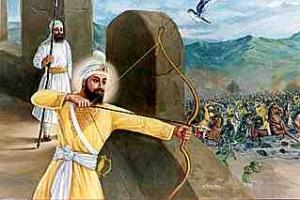To them this appeared like a repeat of the same disaster that had befallen them an hour or two ago. They had not even had time to recover from the previous shock and now they had a second wave of the same enormously vibrant energy. This time the enemy was driven even further back; many just took flight as they thought that the Sikh numbers must have increased and so many of the enemy deserted the battlefield. This new force of six Khalsa soldiers killed many hundreds of the enemy; many simply ran away.
The enemy were stunned by the heavy force and thrust of this second attack and had little choice but to retreat back. The Khalsa unit created a huge void in the enemy territory and a small circle of about 35 metres within the enemy ground was under the control of the Sikhs. No one had the courage to enter into this circle of control. Anyone who entered this area of command was immediately challenged and quickly extinguished. The Khalsa unit, with their backs to the centre of this circular area attacked the enemy courageously and with vigour at the perimeter of the controlled region.
The Guru watched this development with ***** and gratefulness to the Almighty and he knew that the Sikhs had learned the lessons of warfare well and would soon join the many hundreds of Sikh martyrs who had attained the highest honour of Dharam. The Almighty had indeed blessed the Sahibzade and the Sikhs with true bravery and deepest understanding of the Guru's message.
Slowly, due to the huge number of the enemy, they eventually assembled around Baba Jujhar Singh. He was now surrounded and had a Neja (spear) in his hand. Wherever the Neja hit, the enemy was destroyed. He also used a Khanda (double-sword), with which he killed the enemy as a farmer mows down his crop. Guru saw that Jujhar Singh was being surrounded and the opportunity to kill the Mughal soldiers was decreasing. For over 2 hours the Khalsa unit had continued to desolated the enemy. They were becoming tired.
The enemy were stunned by the heavy force and thrust of this second attack and had little choice but to retreat back. The Khalsa unit created a huge void in the enemy territory and a small circle of about 35 metres within the enemy ground was under the control of the Sikhs. No one had the courage to enter into this circle of control. Anyone who entered this area of command was immediately challenged and quickly extinguished. The Khalsa unit, with their backs to the centre of this circular area attacked the enemy courageously and with vigour at the perimeter of the controlled region.
The Guru watched this development with ***** and gratefulness to the Almighty and he knew that the Sikhs had learned the lessons of warfare well and would soon join the many hundreds of Sikh martyrs who had attained the highest honour of Dharam. The Almighty had indeed blessed the Sahibzade and the Sikhs with true bravery and deepest understanding of the Guru's message.
Slowly, due to the huge number of the enemy, they eventually assembled around Baba Jujhar Singh. He was now surrounded and had a Neja (spear) in his hand. Wherever the Neja hit, the enemy was destroyed. He also used a Khanda (double-sword), with which he killed the enemy as a farmer mows down his crop. Guru saw that Jujhar Singh was being surrounded and the opportunity to kill the Mughal soldiers was decreasing. For over 2 hours the Khalsa unit had continued to desolated the enemy. They were becoming tired.
To them this appeared like a repeat of the same disaster that had befallen them an hour or two ago. They had not even had time to recover from the previous shock and now they had a second wave of the same enormously vibrant energy. This time the enemy was driven even further back; many just took flight as they thought that the Sikh numbers must have increased and so many of the enemy deserted the battlefield. This new force of six Khalsa soldiers killed many hundreds of the enemy; many simply ran away.
The enemy were stunned by the heavy force and thrust of this second attack and had little choice but to retreat back. The Khalsa unit created a huge void in the enemy territory and a small circle of about 35 metres within the enemy ground was under the control of the Sikhs. No one had the courage to enter into this circle of control. Anyone who entered this area of command was immediately challenged and quickly extinguished. The Khalsa unit, with their backs to the centre of this circular area attacked the enemy courageously and with vigour at the perimeter of the controlled region.
The Guru watched this development with pride and gratefulness to the Almighty and he knew that the Sikhs had learned the lessons of warfare well and would soon join the many hundreds of Sikh martyrs who had attained the highest honour of Dharam. The Almighty had indeed blessed the Sahibzade and the Sikhs with true bravery and deepest understanding of the Guru's message.
Slowly, due to the huge number of the enemy, they eventually assembled around Baba Jujhar Singh. He was now surrounded and had a Neja (spear) in his hand. Wherever the Neja hit, the enemy was destroyed. He also used a Khanda (double-sword), with which he killed the enemy as a farmer mows down his crop. Guru saw that Jujhar Singh was being surrounded and the opportunity to kill the Mughal soldiers was decreasing. For over 2 hours the Khalsa unit had continued to desolated the enemy. They were becoming tired.
0 Comments
0 Shares
0 Reviews



